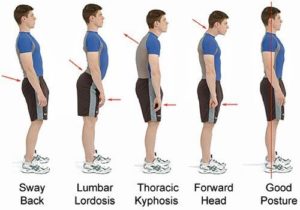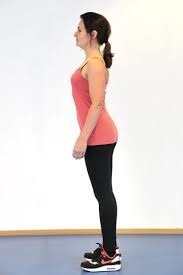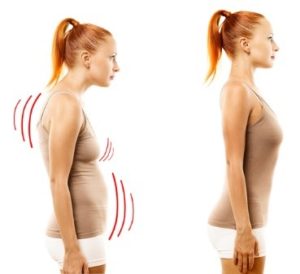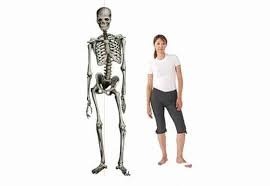Why do we develop pain from poor posture?

Over time, sitting still for hours with poor posture can put stress on your spine and lead to anatomical changes including muscle weakness and degenerative discs and joints. Poor posture is a learned habit that can decrease your range of movement and cause muscle imbalances that affect your daily life and activities. Good posture can be taught easily with the right exercises and physiotherapy.
Examples of poor posture:
Slouching / forward head posture

If you slouch your body is not balanced and your mobility will start to suffer. You may also feel pain due to muscle tightness in your chest, neck, or upper body. The way you sit at your workstation can cause bad posture as your neck is bent forward giving you a “pokey chin”. It is recommended that you adjust your seating at your workstation to the correct height. Also consider taking regular breaks from your workstation to walk around and to do some stretches.
To correct this posture, try upper back, neck and rear shoulder strengthening exercises, and chest stretches. Getting in the habit of holding a good posture whilst standing or sitting will bring long-term benefits.
Exercises to help you correct your slouch include:
- Bridges
- Back extensions
- Plank
- Gently lengthening your neck upwards as you tuck in your chin
- Seated rows in a gym
- Chest stretches
Lumbar lordosis posture/ sticking your bottom out

If you tend to stick your bottom out when in a standing position you may have what is called hyperlordosis. This is an exaggerated inward curve of the lower back that creates a type of “Donald Duck” posture. Holding this position when standing for too long can eventually cause pain and discomfort in your shoulders, spine, back, and bottom. Women who tend to wear high heels often carry this posture as do those who are pregnant or carry excessive weight around the stomach area.
Some exercises to help correct your posture include:
- Plank
- Bridge
- Side lying leg raises
- Hip flexor stretches
- Standing thigh stretches
Standing with a flat back

When standing, you are tucking your pelvis in and your lower back is straight instead of naturally curved. This will cause you to stoop forward. People who tend to maintain this posture find it difficult to stand for long periods of time. This posture is normally caused by muscle imbalances. Spending long periods of sitting down can also contribute to your flat back posture.
Some exercises to help correct a flat back include:
- Plank
- Side lying leg raises
- Chest stretches
- Back extensions
- Bridges
Leaning on one leg

Some lean more on one leg than the other when standing still. Instead of using your core and buttock muscles to keep straight, you are putting added pressure on one side of your lower back and hip. This may develop imbalances around the pelvis area over time that could cause pain in your lower back and buttocks.
Another reason for uneven hips is from carrying heavy backpacks on one shoulder or carrying toddlers around on one hip. To improve your posture, try to get in the habit of standing with your weight evenly distributed on both legs.
Some exercises to help strengthen your buttocks and core muscles to help with this posture include:
- Plank
- Side lying leg raises
- Bridges
Cradling your phone

This is a very common posture issue for many. Placing the phone between your ear and your shoulder places strain on the neck muscles, upper back, and shoulders. The neck and shoulders are not designed to hold this position for any length of time so when we hold that position while talking on the phone we are creating muscle imbalances between both sides of our neck. Try to remember to get into the habit of holding the phone with your hand rather than your neck. Alternatively, use your phone on hands-free.
Some exercises for neck stiffness and pain include:
- Chest stretches
- Neck stretches to the side
- Neck rotations
Ignoring good advice from your doctor or physiotherapist about the importance of keeping a good posture could affect your general health and set you on the path for future neck and shoulder strain, back pain, and even joint damage. It may not feel natural at first to hold a “healthy” posture, but with time your body will adapt and get used to it.
How physiotherapy can help your pain
We will do whatever we can to get you on the fastest route to recovery. Some of the treatment methods we use include:
- Specific exercises for your poor posture
- Mobilisation
- Strengthening exercises
- Myofascial trigger point release
- Pilates
- Cross-friction massage
- Stretching and range of movement exercises
- Acupuncture
- Functional exercises
- Kinesio-taping
